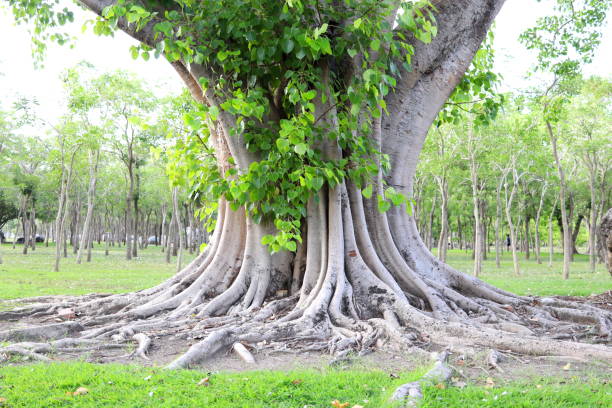India is a land of rich spiritual traditions and ecological diversity, and few symbols represent this fusion better than the Peepal tree (Ficus religiosa). Known as the Bodhi tree in Buddhism and revered in Hinduism and Jainism, the Peepal tree is not just a spiritual icon — it’s also an oxygen-producing powerhouse with remarkable environmental benefits. Planting a Peepal tree isn’t just about cultural reverence; it’s a vital step toward sustainable living, pollution control, and climate action.
Let’s explore why every Indian home, school, and public space should consider planting this sacred tree.
Why the Peepal Tree is Called the ‘Oxygen Giant’
The Peepal tree is famous for its exceptional oxygen-releasing capabilities. While most trees release oxygen during the day, the Peepal tree uniquely continues this process even at night through a modified photosynthetic process known as Crassulacean Acid Metabolism (CAM). This means it absorbs carbon dioxide and releases oxygen round the clock.
Key oxygen benefits:
- Releases oxygen both during day and night
- Absorbs major greenhouse gases like CO₂
- Acts as a natural air purifier in polluted urban areas
- Supports biodiversity with dense canopy
This makes it the perfect oxygen tree to plant in India, especially in cities facing air quality issues.
Cultural and Spiritual Significance of the Peepal Tree
In Indian mythology, the Peepal tree is sacred. It is believed that Lord Vishnu resides in its leaves, and Gautama Buddha attained enlightenment beneath it. People often worship the tree on Saturdays and during special festivals.
But beyond tradition, this reverence has ecological merit. Communities that protect Peepal trees inadvertently preserve biodiversity and encourage sustainable greenery.
Environmental Benefits of Planting Peepal Trees
Besides oxygen, the Peepal tree offers several other ecological benefits:
- Urban cooling: Its large leaves provide deep shade, reducing the urban heat island effect.
- Soil stability: Its deep roots prevent soil erosion, especially on riverbanks and hill slopes.
- Biodiversity hub: Attracts birds, bees, squirrels, and even bats, helping pollination and pest control.
- Groundwater recharge: Helps increase underground water levels due to its expansive root system.
It’s no surprise the Peepal is being promoted as one of the best trees to plant for air purification and environmental restoration.
Ideal Locations for Peepal Tree Plantation
While the Peepal can grow almost anywhere in India, here are the ideal spots to plant it:
- Public parks and community gardens
- School and college campuses
- Near temples and religious sites
- Roadside plantation zones
- Farm boundaries and open rural fields
Note: It’s best to avoid planting Peepal too close to buildings, as its roots can grow extensively.
How to Plant and Care for a Peepal Tree
1. Site selection: Choose an open area with ample sunlight.
2. Soil: Prefers loamy, well-drained soil but adapts well to most soil types.
3. Watering: Water regularly during the first 2 years. Once mature, it requires very little maintenance.
4. Pruning: Minimal pruning needed; remove dead branches seasonally.
5. Growth: It can grow up to 100 feet tall and live for several centuries.
Peepal Tree vs Other Oxygen Trees in India
While the Peepal is undoubtedly a top choice, India is blessed with several other powerful oxygen-producing trees. Here are some comparisons:
- The Neem tree is known for its air-purifying medicinal properties.
- The majestic Banyan tree is another sacred tree and a superb oxygen generator.
- Arjuna tree is both a heart-friendly herb and an environmental guardian.
- Ashoka tree adds elegance to gardens while improving air quality.
- The Moringa tree is known as the miracle tree for its nutrients and oxygen release.
- Gulmohar combines floral beauty with air purification.
- The Saptaparni tree releases oxygen even at night like the Peepal.
- Tamarind and Kadamba also provide excellent environmental support.
Planting any of these trees along with the Peepal creates a diversified oxygen garden.
Eco-Awareness: Peepal Tree in Urban India
In metro cities where pollution is high and green cover is low, the Peepal tree serves as a silent savior. Government and NGOs are already running plantation drives including Peepal in roadside, school, and hospital greening projects.
Creating awareness about planting oxygen trees in Indian cities like the Peepal is key to reversing the impact of climate change and deforestation.
FAQs About the Peepal Tree
Q1: Can I plant a Peepal tree at home?
A: You can, but ensure it’s at a distance from buildings due to its strong roots. Plant it in a backyard or near a boundary wall if space permits.
Q2: Is the Peepal tree really oxygenating at night?
A: Yes, due to its CAM-type photosynthesis, it continues oxygen production even after sunset, unlike most trees.
Q3: How long does a Peepal tree take to mature?
A: It grows steadily and becomes a full-fledged shade tree in about 8–10 years but continues to expand throughout its life.
Q4: Is the Peepal tree suitable for urban plantation?
A: Yes, especially in parks, campuses, and public lands — just avoid small private yards.
Q5: Why is the Peepal tree worshipped in India?
A: It symbolizes longevity, wisdom, and divine energy. Ancient scriptures and rituals link it to gods and spiritual awakening.
Q6: How does the Peepal tree support wildlife?
A: Its fig fruits and dense foliage attract a variety of birds, insects, and small animals, enriching local ecosystems.
Conclusion: Planting the Peepal is Planting a Future
With its round-the-clock oxygen production, spiritual importance, and low-maintenance nature, the Peepal tree is more than just greenery — it’s a green revolution waiting to be planted. Every Indian should take pride in protecting and planting this sacred oxygen tree.
For those serious about creating a better environment, don’t stop at Peepal. Explore other oxygen trees like the Neem tree, Banyan tree, and Arjuna tree to build a green legacy.
Let’s make India greener — one Peepal tree plantation at a time.
Visit treesplantsinfo.com for more guides and tree plantation tips.
